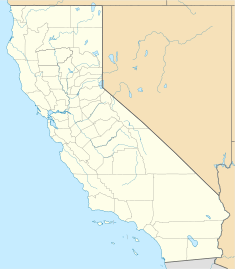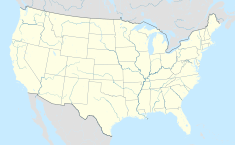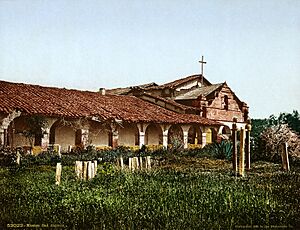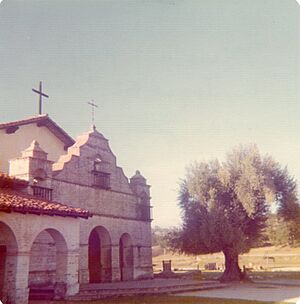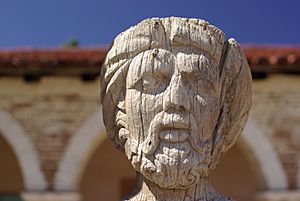Mission San Antonio de Padua facts for kids
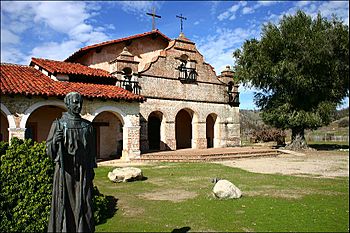
The reconstructed Mission San Antonio de Padua as it appears today. The baked brick Campanario is unique among the Missions.
|
|
| Coordinates | 36°00′54″N 121°15′00″W / 36.01500°N 121.25000°W |
|---|---|
| Name as founded | La Misión de San Antonio de Padua |
| English translation | The Mission of Saint Anthony of Padua |
| Patron | Saint Anthony of Padua |
| Nickname(s) | "Mission of the Sierras" |
| Founding date | July 14, 1771 |
| Founding priest(s) | Father Junípero Serra |
| Founding Order | Third |
| Military district | Third |
| Native tribe(s) Spanish name(s) |
Salinan |
| Native place name(s) | Telhaya |
| Baptisms | 4,419 |
| Marriages | 1,142 |
| Burials | 3,617 |
| Secularized | 1834 |
| Returned to the Church | 1862 |
| Governing body | Roman Catholic Diocese of Monterey |
| Current use | Parish Church |
| Designated | 1976 |
| Reference no. | 76000504 |
| Reference no. | 232 |
| Website | |
| http://www.missionsanantonio.net | |
Mission San Antonio de Padua is a historic Spanish mission. It was built by the Franciscan order in what is now Monterey County, California. You can find it near the town of Jolon.
The mission was started on July 14, 1771. It was the third mission founded in Alta California by Father Presidente Junípero Serra. This mission was special because it was the first in Upper California to use fired tile roofing. Today, Mission San Antonio de Padua is a parish church. It belongs to the Diocese of Monterey. It no longer does the original mission work it was created for.
Contents
History of Mission San Antonio
How the Mission Started
Mission San Antonio de Padua was the third mission built in Alta California. Father Junipero Serra chose the spot on July 14, 1771. He named the mission after Saint Anthony of Padua. Saint Anthony was born in 1195 in Portugal. He is known as the patron saint of people who are poor.
Father Serra left Fathers Miguel Pieras and Buenaventura Sitjar to continue building. The main church building did not start until 1810. By that time, about 178 Native Americans lived at the Mission. Most were from the Northern Salinan tribe. Some were also from the Yokuts and Esselen tribes.
By 1805, the number of people living there grew to 1,300. But in 1834, new laws changed how missions were run. These were called secularization laws. After these laws, only 150 Mission Indians remained at Mission San Antonio. Unlike other missions, no town grew up around this one.
In 1845, the Mexican Governor Pío Pico said all mission buildings in Alta California were for sale. But no one wanted to buy Mission San Antonio. In 1863, after almost 30 years, the Mission was given back to the Catholic Church. In 1894, some roof tiles from the mission were used. They were put on a train station building in Burlingame, California. This was one of the first buildings made in the Mission Revival Style.
Bringing the Mission Back to Life
The first try to rebuild the Mission happened in 1903. The California Historical Landmarks League started holding events there. They wanted to save and fix up Mission San Antonio. The Native Sons of the Golden West gave $1,400 to help. Workers removed tons of dirt and trash from inside the chapel. They also fixed holes in the side walls.
Sadly, a big earthquake in 1906 badly damaged the building. In 1928, Franciscan friars started holding church services at San Antonio de Padua again. It took almost 50 years to fully restore the Mission. The State of California now requires a big project to make the mission safe from earthquakes. This project costs $12–15 million and must be done by 2015. If not, the mission might close. As of 2011, 35 private families were helping to keep the mission open. There is a strong effort to raise money for these repairs.
The Mission's New Purpose
Even though it is still called a mission, Mission San Antonio de Padua no longer focuses on its original mission work. It has become more of a parish church. It also hosts group events and has gift shops and a museum for visitors. In 2005, the Franciscan Friars gave the mission's care and ownership to the Diocese of Monterey. Under the Diocese of Monterey, Mission San Antonio de Padua became a Catholic parish. It also welcomes groups, has gift shops, and a museum with picnic areas.
Mission San Antonio Today
Today, the closest city is King City, which is about 29 miles (47 km) away. Jolon, a small town, is 6 miles (10 km) from the Mission. Historians believe the Mission's peaceful location is a great example of early mission life. It sits in the valley of the San Antonio River. It is also near the Santa Lucia Mountains.
The mission is surrounded by the Fort Hunter Liggett Military Reservation. The U.S. Army bought this land from the Hearst family during World War II. They used it to train soldiers. More land was bought from the Army in 1950. This made the mission area larger, over 85 acres (340,000 m²). This fort is still used for training soldiers today.
Mission San Antonio de Padua is one of the places you can visit on the Juan Bautista de Anza National Historic Trail.
As of 2013, Franciscan Friar Jeff Burns OFM is in charge of the Mission.
Images for kids
-
Photograph of Mission San Antonio de Padua by landscape photographer Carleton Watkins, dating from 1873-1883.
See also
 In Spanish: Misión San Antonio de Padua para niños
In Spanish: Misión San Antonio de Padua para niños


